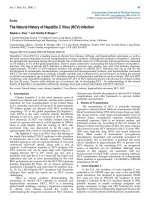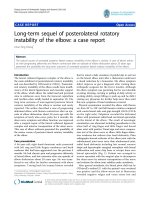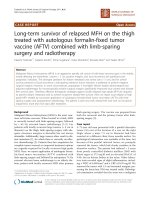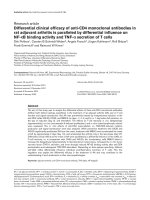Báo cáo y học: "Long Term Persistence of IgE Anti-Influenza Virus Antibodies in Pediatric and Adult Serum Post Vaccination with Influenza Virus Vaccine"
Bạn đang xem bản rút gọn của tài liệu. Xem và tải ngay bản đầy đủ của tài liệu tại đây (423.38 KB, 6 trang )
Int. J. Med. Sci. 2011, 8
239
I
I
n
n
t
t
e
e
r
r
n
n
a
a
t
t
i
i
o
o
n
n
a
a
l
l
J
J
o
o
u
u
r
r
n
n
a
a
l
l
o
o
f
f
M
M
e
e
d
d
i
i
c
c
a
a
l
l
S
S
c
c
i
i
e
e
n
n
c
c
e
e
s
s
2011; 8(3):239-244
Research Paper
Long Term Persistence of IgE Anti-Influenza Virus Antibodies in Pediatric
and Adult Serum Post Vaccination with Influenza Virus Vaccine
Tamar A. Smith-Norowitz
1,5
, Darrin Wong
2
, Melanie Kusonruksa
2
, Kevin B. Norowitz
1,5
, Rauno Joks
3,5
,
Helen G. Durkin
2,5
, Martin H. Bluth
4
1. Departments of Pediatrics, S.U.N.Y. Downstate Medical Center, Brooklyn, New York 11203, USA
2. Departments of Pathology, S.U.N.Y. Downstate Medical Center, Brooklyn, New York 11203, USA
3. Departments of Medicine, S.U.N.Y. Downstate Medical Center, Brooklyn, New York 11203, USA
4. Department of Pathology, Wayne State University School of Medicine, Detroit, Michigan, 48201, USA
5. Center for Allergy and Asthma Research, S.U.N.Y. Downstate Medical Center, Brooklyn, New York 11203, USA
Corresponding author: Tamar A. Smith-Norowitz, Ph.D., SUNY Downstate Medical Ctr., Dept of Pediatrics, Box 49, 450
Clarkson Ave., Brooklyn, New York 11203, (718) 270-1295, (718) 270-3289 (fax),
© Ivyspring International Publisher. This is an open-access article distributed under the terms of the Creative Commons License (
licenses/by-nc-nd/3.0/). Reproduction is permitted for personal, noncommercial use, provided that the article is in whole, unmodified, and properly cited.
Received: 2010.12.22; Accepted: 2011.02.07; Published: 2011.03.18
Abstract
The production of IgE specific to different viruses (HIV-1, Parvovirus B19, Parainfluenza virus,
Varicella Zoster Virus), and the ability of IgE anti-HIV-1 to suppress HIV-1 production in vitro,
strongly suggest an important role for IgE and/or anti viral specific IgE in viral pathogenesis.
Nevertheless, the presence and persistence of IgE anti-Influenza virus antibodies has not been
studied. Total serum IgE and specific IgE and IgG anti-Influenza virus antibodies were studied
in children (N=3) (m/f 14-16 y/o) and adults (N=3) (m/f, 41-49 y/o) 2-20 months after vac-
cination with Influenza virus (Flumist
®
or Fluzone
®
), as well as in non-vaccinated children
(N=2). (UniCAP total IgE Fluoroenzymeimmunoassay, ELISA, Immunoblot). We found that
serum of vaccinated children and adults contained IgE and IgG anti-Influenza virus antibodies
approaching two years post vaccination. Non-vaccinated children did not make either IgE or
IgG anti-Influenza antibodies. Similar levels of IL-2, IFN-γ, IL-4, and IL-10 cytokines were
detected in serum of vaccinated compared with non vaccinated subjects (p>0.05), as well as
between vaccinated adults compared with vaccinated children and non vaccinated subjects
(p>0.05). Vaccinated children and adults continue to produce IgE anti-Influenza virus anti-
bodies long term post vaccination. The long term production of IgE anti-Influenza virus an-
tibodies induced by vaccination may contribute to protective immunity against Influenza.
Key words: IgE, Influenza virus, Influenza virus vaccine
INTRODUCTION
Previous studies in our laboratory have investi-
gated the role of IgE and the immune response to
specific viruses including: Parvovirus B19 in children
[1], HIV-1 in HIV-1 seropositive, non progressor pe-
diatric patients [2, 3], Varicella Zoster Virus (VZV) [4,
5], as well as in both children and adults with a past
history of chicken pox infection or VZV vaccination
[6]. Other studies in our laboratory also identified IgE
anti- spirochete antibodies (B. Burgdorferi) and its
persistence one year later in serum of lyme-infected
children [7].
Studies in humans and animals reported by
others have identified IgE anti-virus antibodies in
several viral infections including respiratory syncytial
virus (RSV) [8, 9], parainfluenza [10], HTLV-1 [11],
Puumala virus [12], HSV-1, HSV-2, and Epstein-Barr
Int. J. Med. Sci. 2011, 8
240
virus [13], and blue tongue virus in cattle [14].
Studies of Grunewald, et al., reported Influenza
A virus-specific IgE antibodies in the serum of in-
fected mice, and showed local anaphylaxis after re-
challenge with the Influenza A virus antigen; these
mice developed virus-specific mast cell degranulation
in the skin [15]. Recent studies of Davidsson, et al
demonstrated in healthy human subjects, with no
known allergy, IgE responses against Influenza A
[16]. No anaphylactic reactions were associated with
vaccination [16]. However, serum IgE levels were
increased after Influenza vaccination, which might
indicate a participation of IgE in viral defense [16].
Earlier studies of Dobber, et al also found that IgE
specific Influenza virus antibodies were increased
after influenza vaccination in mice [17]. Interestingly,
low levels of total Influenza virus-specific antibody
secreting cells (ASCs) have been reported in blood,
tonsils, and nasal mucosa of non-allergic study sub-
jects that had not been recently vaccinated or natu-
rally infected with Influenza virus [18]. In their earlier
studies, they found that Influenza virus-specific an-
tibodies in the oral fluid (saliva) consist mainly of
secretory IgA (sIgA) [19].
This study is the first, to our knowledge, to de-
scribe the long term persistence of IgE anti-Influenza
virus antibodies in serum of IgE positive and negative
vaccinated pediatric and adult subjects, approaching
two years post vaccination. The exact role of IgE in
Influenza virus infection remains to be elucidated;
however, the presence of IgE anti Influenza virus an-
tibodies several months post vaccination warrants
further investigation of the biological significance, if
any, of these antibodies.
MATERIALS AND METHODS
Patient specimen description
Peripheral blood (3 ml total) was obtained from
both pediatric (N=3) (m/f, 14-16 yrs old) and adult
(N=3) (m/f, 41-49 yrs old) Caucasian subjects from the
SUNY Downstate Allergy Clinic, who were both
atopic and non atopic, with normal (<100 IU/mL) or
elevated serum IgE levels. Atopic subjects were skin
prick positive (N=2) for environmental (e.g. mixed
tree and grass, ragweed, weeds, and dust mite) or
food allergens. Exclusion criteria included food al-
lergy to egg and antibiotics. At the time of study, the
subjects had not received allergy therapy, and were
not being treated with any medication. Subjects did
not have a past history of parasite infection. Approval
was obtained from the SUNY Downstate Institutional
Review Board, and the procedures followed were in
accordance with institutional guidelines involving
human subjects.
Vaccine description
All adults were vaccinated with Influenza Virus
Vaccine Fluzone
®
(inactivated Influenza Virus Vac-
cine, 2009-2010 Formula; Sanofi Pasteur Inc., Swift-
water, PA) and children were vaccinated with
Flumist
®
(live attenuated Influenza Virus Vaccine,
Intranasal, 2009-2010 Formula; MedImmune,LLC,
Gaithersburg, MD). Each 0.25 mL dose of Fluzone
vaccine contains 7.5 mcg of influenza virus hemag-
glutinin (HA) and each 0.5 mL dose contains 15 mcg
HA from each of the following 3 viruses:
A/Brisbane/59/2007, IVR-148 (H1N1),
A/Uruguay/716/2007/, NYMC X-175C (H3N2) (an
A/Brisbane/10/2007-like virus), and B/Brisbane/60
/2008. Each 0.2 mL dose of Flumist intranasal spray
contains 10 FFU (fluorescent focus units) of live at-
tenuated influenza virus reassortants of each of the
three strains for the 2009-2010 season:
A/California/7/2009 (H1N1), A/Perth/16/2009
(H3N2), and B/Brisbane/60/2008.
Time post vaccination for subjects was 2-20
months. Past history of vaccination was confirmed by
positive immunoblot for IgG anti Influenza virus. (See
methods below.)
Total serum IgE
Blood was collected and immunoglobulin (Ig)
levels (IgE) were detected in serum (Quest Diagnos-
tics, Inc. Teterboro, NJ), which was performed ac-
cording to manufacturer’s recommendation. Refer-
ence range for healthy adult or child serum: IgE:
20-100 IU/mL.
Influenza virus serum antibody detection: Im-
munoblot
The presence of IgE or IgG anti-Influenza anti-
bodies was determined by immunoblot (dot blot), as
previously described [5, 6]. Briefly, Influenza virus
vaccine Fluzone (5ul) (90 ug/mL protein conc.) was
pipetted onto nitrocellulose membrane strips
(BIO-RAD Laboratories, Hercules, CA) and let dry.
Nitrocellulose membrane was then soaked in a 5%
milk powder (Immunetics Inc., Boston, MA) solution
(Tween 20 (0.05% Tween20 (Sigma) in tris buffered
saline (20mM Tris-HCL (Sigma), 150 mM NaCl, pH7.5
(Sigma).
Detection of IgE anti Influenza
Nitrocellulose membranes were then incubated
with serum samples (100 ul) (diluted in 2 ml
TBS-Tween 20) for 1 hr at room temperature, after
which goat IgG fraction to human IgE (MP Biomedi-
cals, Solon, OH), diluted 1:20-40 in TBS-Tween 20 and
Int. J. Med. Sci. 2011, 8
241
1% milk in TBS-Tween 20 (1 ml), was added to mem-
branes, and incubated overnight on a shaker at room
temperature.
Detection of anti Influenza IgG
IgG Fraction goat anti human IgG (heavy and
light chains specific) (ICN/Cappell, West Chester,
PA), diluted 1:100 in TBS-Tween 20 and 1% milk in
TBS-Tween 20 (1ml) was added to membranes and
incubated for one hour on a shaker at room tempera-
ture. The membranes were then washed three times
with TBS-Tween 20.
For detection and development of both IgG and
IgE isotypes: nitrocellulose membranes were then
incubated with rabbit anti-goat peroxidase labeled
antibody (whole molecule) (Cappel, West Chester,
PA), diluted 1:2000 in TBS-Tween 20 and 1% Milk for
1 hour on a shaker, washed 3 times with TBS-Tween
20, and then developed in TMB substrate solution (2
ml). The membranes were then removed from the
TMB substrate solution, at which time they were read
dried, and scanned (Gel Doc 2000 System with spe-
cific The Discovery Series: Quantity One software
BioRad, Hercules, CA).
Cytokine determination
Serum cytokines [Interleukin-2 (IL-2), Interferon
gamma (IFN-γ), Interleukin-4 (IL-4), Interluekin-10
(IL-10)] were determined by sandwich ELISA (Bio-
source, Camarillo, CA) according to the manufactur-
er’s protocol.
Statistical Analysis
Cytokine determinations from vaccinated and
non vaccinated subjects were compared on each var-
iable. Significance between variables was determined
using student’s t-tests. A p value of <0.05 was con-
sidered statistically significant for all comparisons.
The degree of association between these measures
was assessed using Pearson’s correlations. Statistical
analyses were performed using SPSS for Windows,
version 10.0 software (SPSS Inc., Chicago, IL).
RESULTS.
1. Characteristics of Study Subjects
Serum IgE levels and IgE and IgG anti-Influenza
virus antibodies were studied in children (N=3) (m/f
14-16 y/o) and adults (N=3) (m/f, 41-49 y/o) ap-
proaching two years post vaccination, as well as in
non infected, non-vaccinated children (N=2) (m/1
y/o) (Table 1).
2. Total IgE
Total serum IgE levels were both normal and
elevated in adults and children vaccinated with In-
fluenza virus. Children with no history of either In-
fluenza virus infection or vaccination had serum IgE
levels which were low (Table 1).
3. Anti-Influenza Abs
IgG. Serum obtained from subjects who were
vaccinated had positive dot blots for IgG an-
ti-Influenza virus antibodies (Data not shown). In
contrast, serum from non-infected, non-vaccinated
(control) subjects did not contain IgG anti-VZV anti-
bodies.
IgE. Serum obtained from 5 out of 6 vaccinated
subjects (83%) had positive dot blots for IgE an-
ti-Influenza virus antibodies; they had either elevated
or normal levels of serum IgE (Table 1) (Fig 1, lanes 1,
2). In contrast, serum from non-infected, non vac-
cinated subjects did not contain IgE anti-Influenza
virus antibodies (Fig 1, lane 3); they had low levels of
serum IgE.
TABLE 1. CHARACTERISTICS OF STUDY SUBJECTS AND SERUM IgE LEVELS
Patient Sex/Age (years) Form of Influenza virus inocula-
tion (Fall 2009)
Serum IgE levels
(IU/ml)
IgE anti- Influenza
virus (+/-)
#
IgG anti-Influenza virus
(+/-)
#
1 F (18) Flumist
®1
154* + +
2 F (41) Fluzone
®2
15 + +
3 M (44) Fluzone 232* + +
4 M (14) Flumist 34 + +
5 M (16) Flumist** 132 - +
6 F(49) Fluzone 34 + +
7 M (1) None 14 - -
8 M(1) None 15 - -
Patients were inoculataed with either
1
Flumist
®
(live attenuated Influenza Virus Vaccine),
2
Fluzone
®
(inactivated Influenza Virus Vaccine) or none. *Patient skin test (skin prick) positive for food or environmental allergens. Refer-
ence range for healthy adult or child serum: IgE: 20-100 IU/mL.**Was given Flumist in 2008.
# Immunoblot (See Material and Methods).
Int. J. Med. Sci. 2011, 8
242
Figure 1. Immunoblot analysis of IgE anti-influenza virus antibodies. Serum from subjects with past history of
influenza virus vaccination or no infection was incubated with nitrocellulose strips containing influenza virus vaccine antigen
(see Materials and Methods). Lane 1: representative blot of subject vaccinated with influenza virus vaccine, who had elevated
serum IgE levels (>100 IU/ml). Lane 2: representative blot of subject vaccinated with influenza virus vaccine who had low
serum IgE levels (<100 IU/ml). Lane 3: control subject, no history of infection or vaccination.
4. Cytokines in serum.
Similar levels of IL-2, IFN-γ, IL-4, and IL-10 cy-
tokines were detected in serum of vaccinated com-
pared with non vaccinated subjects (p>0.05), as well
as between vaccinated adults compared with vac-
cinated children, compared with non vaccinated sub-
jects (p>0.05) (data not shown).
DISCUSSION
The present studies are the first to describe the
long-term persistence of IgE anti-Influenza virus an-
tibodies in vaccinated children and adults, with nor-
mal and elevated levels of serum IgE, approaching
two years post vaccination.
Influenza viruses are respiratory pathogens
which belong to the Orthomyxoviridae family [20],
and are a group of negative-stranded, segmented
RNA viruses [20]. Three types of influenza virus (A, B,
C) have been reported which are categorized by their
antigenic differences in the nucleoprotein and matrix
protein [21]. Influenza A and B viruses commonly
cause disease in humans [21]. The Influenza A virus
has surface antigens, but diverse subtype-specific,
haemagglutinin (HA) and neuraminidase (NA); an-
tibodies to these viral antigens mediate immunity to
infection [21]. When an influenza virus infection is
first experienced, an IgM response is elicited to both
type and subtype-specific antigens of influenza virus
[22]; subsequent infections or vaccinations later in life
to the type-specific antigens would be restricted to
IgG responses [22].
Influenza virus causes annual epidemics, which
generally occur in the winter months in the Northern
hemisphere [21], and is spread from person to person
by either direct contact with a virus infected individ-
ual, or by virus droplets from sneezing or coughing
[21]. An uncomplicated case of influenza will resolve
within 1-2 weeks; however, in patients with other
underlying medical conditions, infection with influ-
enza may result in hospitalization and death [21].It
has been reported that influenza has been responsible
for high numbers of morbidity and mortality in the
United States [23]. All age groups can be infected with
Influenza virus, but children have the highest infec-
tion rates [24]. In the United States, vaccination is
recommended for people with increased rate of med-
ical conditions (50-64 y/o), and for children 6 months
and older [21, 25]. In some countries, vaccination is
recommended for health care workers, and caregivers
in nursing homes and assisted living facilities [21].
It is well known that both humoral (mucosal and
serum antibody responses), as well as cellular im-
mune responses play a role in resistance to influenza
infection [26-29]. sIgA, as well as IgM are the neutral-
izing antibodies in the mucosa that prevent virus en-
try and inhibit virus replication [30]. During primary
infection, IgG, IgA and IgM- specific to HA have been
detected in nasal washings by enzyme-linked im-
munosorbent assay, although IgA and IgM were more
frequently detected than IgG [30]; IgE-specific to HA
was not studied. Natural wild type Influenza virus
infection can stimulate a local IgA response, which
can last 3-5 months, as well as influenza-specific
IgA-committed memory cells [30]. Levels of neutral-
izing antibodies induced by live virus vaccine corre-
late with resistance to infection after challenge with
wild-type virus [28]. Previous studies by others re-
ported that during primary infection, IgG, IgA, and
IgM can be detected within 10-14 days [30]. Two
weeks post infection, levels of IgA and IgM peak, and
then begin to decline, whereas four to six weeks post
infection, levels of IgG peak [30]. In the primary re-
sponse IgG and IgM are dominant, and after second-
Int. J. Med. Sci. 2011, 8
243
ary infection, IgG and IgA are the predominant im-
munoglobulin isotypes detected in serum [21, 30].
It has been reported that in vaccinated individu-
als, 2-6 days post vaccination, serum antibody re-
sponses to trivalent (inactivated) influenza vaccine
were detected, peaked 2-3 weeks post vaccination,
and then was two-fold lower 6 moths post vaccination
[31]; influenza specific IgG1 antibodies were the
dominant antibody detected, as well as lower levels of
IgM and IgA [31]; IgE antibodies were not studied. It
should be mentioned that in the United States, mu-
cosal vaccines for Influenza are now available for
children, and target the mucosa and lymphoid tissue,
which are areas where early infection occurs [32]. In
other investigations, it has been shown that influenza
virus-specific antibodies in saliva consist of SIgA1,
which is first detected 5-7 days after vaccination, and
the elevated antibody response lasts for 3-5 days [19,
31]. However, an increase of H1N1 and B strains in-
fluenza virus antibodies has been found in oral fluid 7
days post vaccination [18]. Levels of influenza vi-
rus-specific ASCs in blood is low before vaccination,
compared with levels in tonsils and nasal mucosa [18];
after vaccination, this level increased nearly 4 log
10
[18]. Live, attenuated influenza vaccines induce both
mucosal and systemic responses [21]. The
cold-adapted (CA) live, attenuated vaccines are ad-
ministered intranasally in children and provide pro-
tective immunity [21]. After CA vaccination, serum
antibody responses and/or virus shedding has been
noted in most recipients [21].
In the present study, vaccinated adult (live at-
tenuated vaccine) and pediatric (nasal vaccine) pa-
tients (2-20 months post vaccination), with both nor-
mal and elevated serum IgE levels, had specific IgG
and IgE anti-influenza antibodies, detected by im-
munoblot. Of notable interest under study, is the
long-term persistence of these antibodies (approach-
ing two years post vaccination). Although prior liter-
ature suggests that Influenza virus specific IgG anti-
bodies wane 6 months post vaccination [31], we were
able to detect both IgG and IgE specific Influenza vi-
rus antibodies up to two years post vaccination. It is
conceivable that the detection of IgG and IgE reported
here (dot blot technology) affords a greater level of
sensitivity than previous reports which employ
ELISA based approaches. In this manner our data are
consistent with the detection of other reports with
respect to immunoglobulin anti-influenza presence.
However, in our studies, the levels of Ig anti-influenza
antibodies over time were not determined.
Given the findings of this study, the presence
and persistence of IgG and IgE anti-influenza anti-
bodies in the serum from those with normal and ele-
vated levels of IgE are understandable. Our findings
appear to be of importance and relevant because pre-
viously described studies from our laboratory [33]
have shown the presence of IgE anti-cancer antibodies
present in patients with both normal and elevated IgE
levels which were able to mediate antibody depend-
ent cell mediated cytotoxicity against cancer cells in
vitro. These responses were not correlated with total
serum IgE levels. We therefore speculate that it is not
the total IgE levels that are important but rather the
fraction of IgE anti-influenza antibodies as a percent-
age of the total IgE pool that are responsible for me-
diating any effects. Our discovery also suggests that
the IgE molecule has evolved to serve various benefi-
cial functions, including anti-viral. However, at pre-
sent, it is unclear how IgE promotes its activity in
these viruses.
Although IgE anti-viral responses are demon-
strated, the limitations of this study include small
sample size, and the lack of racial disparity. All the
subjects were Caucasian and in good health. It could
be that the immunoglobulin anti-viral responses may
differ in vaccinated subjects of African American or
Hispanic descent as has been shown in other vaccine
trials (34). Additional studies towards understanding
immunoglobulin anti-viral responses in subjects and
patients with co-morbidities or immunocompromise
are warranted.
The results presented here suggest that IgE is
associated with anti-influenza immunity and their
memory responses. Further studies are necessary to
elucidate the role of immunoglobulins in influenza
infection and to determine possible functional roles of
IgE in this disease and its relationship to viral patho-
physiology.
Conflict of Interest
The authors have declared that no conflict of in-
terest exists.
References
1. Bluth MH, Norowitz KB, Chice S, Shah VN, Nowakowski M,
Josephson AS, Durkin HG, Smith-Norowitz TA. Detection of
IgE anti-parvovirus B19 and increased CD23+ B cells in parvo-
virus B19 infection: relation to Th2 Cytokines. Clin. Immunol
2003; 108:152-158.
2. Secord EA, Kleiner GI, Auci DL, et al. IgE against HIV proteins
in clinically healthy childen with HIV disease. J Allergy Clin
Immunol 1996; 98: 979-84.
3. Pellegrino MG, Bluth MH, Smith-Norowitz TA, et al. HIV-1
Specific IgE in serum of long term surviving children inhibits
HIV-1 production in vitro. AIDS Res. Hum. Retroviruses 2002;
18: 363-72.
4. Lev Tov H, Josekutty J, Kohlhoff S., Norowitz KB, Silverberg JI,
Chice S, Nowakowski M, Durkin HG, Bluth MH,
Smith-Norowitz TA. IgE anti-varicella virus (VZV) and other









